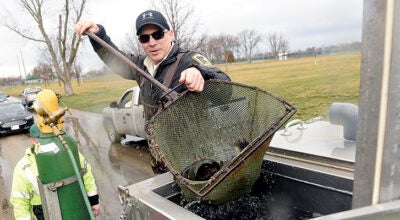The Wide Angle: The mad science of meadery
Published 5:05 am Saturday, January 25, 2020
A number of years ago, I stood in the kitchen of Kevin and Jill Jones, watching Kevin mix a new batch of home-brewed wine for fermentation.
At the time I found the concept of home brewing mildly interesting, but not interesting enough to fully grab my attention. However, on and off over the next few years I did a few more stories involving the Jones, including the opening of their microbrewery The Angry Hog, and I found myself becoming more curious.
Then I did another story on home brewing, this time with Cody Anderson, he of Plunging for Pink emceeing fame. As he took me through his process, I discovered myself asking questions, not so much for the story, but for my own interest.
By now you can probably see where this is going and you are absolutely right in the proper amount of skepticism you are now showing.
I can’t see you showing this skepticism, but I know you by now, dear reader, just as you know that there is probable cause to suspect this could end with alcohol all over the floor of our basement.
The pull to actually try home brewing has only really started to surface in the last couple years, with no real urge to go much beyond brewing for my own simple tastes. Given how this could go, I see no reason to take down a small business venture along with it.
But lately, the urge has taken on a stronger pull as I’ve started thinking more and more about the idea of brewing mead at home.
Mead is an absolutely marvelous drink, expertly brewed by the Norse using honey. I’ve had drinks that have come close to mead, but aside from the Renaissance Festival, I have only really had real mead once in my life when a buddy of mine brought me back a bottle from Ireland.
I fell in love with it immediately, and as I began to give more and more thought to this idea of dipping into alcoholic chemistry, my thoughts immediately drifted towards mead.
However, there comes a problem the further along I go and it is this — chemistry.
I’ve written more than a few times in this space you so stubbornly read that I was never a fan of math. However, this spreads a little further when I tell you that science in general seemed to baffle me, which has always been weird because I like science. I enjoy those things that come from science, but it doesn’t change the fact that I’m bad at it.
Math, chemistry, physics and all the rest of these related field of studies really confounded me and caused everything to be a head scratcher, and now I’m thinking about trying something that requires a certain level of chemistry and maybe a little bit of math.
I know what you may be thinking. “But Eric, there are beginners kits.”
Yeah, I know, and a lot of the kits come with such assurances as, “certified frustration-free.” And yet … AND YET! … we all know by now that I am every bit capable of fouling this up. It’s what I excel at. Find simple things, make them as complicated as possible and ultimately screw it up.
Which is daunting when I have to — at minimum — buy kits with a bunch of honey that costs a pretty penny.
There is not just a notion of failure here. There’s a spectacular notion of failure, specifically including a fear of coming home and finding exploded bottles of sticky mead all over the basement floor with drunk cats.
Now I know this is probably a worst case scenario and I’m probably overthinking the effort, and there have been some instances where I pulled off the improbable. Remember, I once repaired a taillight all by my lonesome self.
Still, we have to consider the idea, maybe even expect it, that this will go wrong in ways I haven’t even thought of yet.
But on the other side of things, mead is really, really good and at some point in life, don’t you think we have to try something new?
I think I’ve now convinced myself that this will happen, which should bode well for you all. Imagine a summer of not only garden hijinks, but home brewery hijinks as well.
The things I do for you people.




